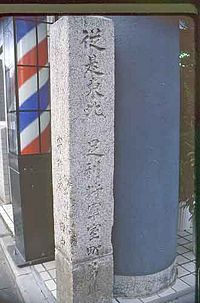Ashikaga shogunate
The Ashikaga shogunate Japanese Ashikaga bakufu, 1336–1573) was a feudal military dictatorship ruled by the shoguns of the Ashikaga family. Shoguns were de facto rulers of Japan although the authority of the Emperor was nominally acknolwedged. He was kept in imperial isolation as a distant but revered figure while governance devolved to the military dynasties.
This period is also known as the Muromachi period and gets its name from the Muromachi area of Kyoto where the third shogun Yoshimitsu established his residence. Local nobles, the daimyo, also exercised considerable power and the Shogun could only rule with the co-operatio and support of these men. Consequently, much skill was required and the Shogun was forced to consider the regional nobles' interests as well as his own. The Shogunate began by re-opening contact and commerce with China and ended with the first contact with Europeans, including Christian missionaries.
The Ashikaga relationship with the Emperor
In part because the founder of the Ashikaga shogunate, Ashikaga Takauji, did so by siding with the Emperor against the previous Kamakura shogunate, the Ashikagas shared more of the governmental authority with the Imperial government than the Kamakura had. Thus, it was the weakest shogunate when compared with the Kamakura shogunate and the Tokugawa shogunate. However, most of the regional power still remained with the provincial daimyo, and the military power of the shogunate depended largely on their loyalty to the Ashikaga. As the daimyo increasingly feuded among themselves in the pursuit of power, that loyalty grew increasingly strained, until it erupted into open warfare in the late Muromachi period, also known as the Sengoku Period. Ahikaga Takauji re-opened trade with China and commissioned the ilver Pavilion (Ginkaku-ji). The Onin Wars (1467-1477) between varuous daimyo's resulted in political fragmentation. As the daimyos' power increased, they supported alternative candidates for the imperial succession, further complicating the already complex situation so that the Shogun's power became as nominal as that of their declared Emperor, who did not attract universal recognition.
The Ashikaga shogunate was destroyed in 1573 when Oda Nobunaga drove the 15th and last Ashikaga shogun Ashikaga Yoshiaki out of Kyoto. Afterwards, Yoshiaki sought and received protection from the Mori clan in western Japan and later was requested by Toyotomi Hideyoshi to accept him as an adopted son and 16th Ashikaga Shogun but Yoshiaki refused. The Ashikaga family still survive to this day. Towards the end of this shogunate, the number of smaller daimyo had increased due to political fragmentation. By 1543, the first Europeans (the Portuguese) had arrived in Japan intent on trade. Fire arms were introduced to Japan at this time.
The Shoguns of the Dynasty
- Ashikaga Takauji (1305–1358) (r. 1338–1358)
- Ashikaga Yoshiakira (1330–1368) (r. 1359–1368)
- Ashikaga Yoshimitsu (1358–1408) (r. 1368–1394)
- Ashikaga Yoshimochi (1386–1428) (r. 1395–1423)
- Ashikaga Yoshikazu (1407–1425) (r. 1423–1425)
- Ashikaga Yoshinori (1394–1441) (r. 1429–1441)
- Ashikaga Yoshikatsu (1434–144]) (r. 1442–1443)
- Ashikaga Yoshimasa (1436–1490) (r. 1449–1473)
- Ashikaga Yoshihisa (1465–1489) (r. 1474–1489)
- Ashikaga Yoshitane (1466–1523) (r. 1490–1493, 1508–1521)
- Ashikaga Yoshizumi (1480–1511) (r. 1495–1508)
- Ashikaga Yoshiharu (1510–1550) (r. 1522–1547)
- Ashikaga Yoshiteru (1536–1565) (r. 1547–1565)
- Ashikaga Yoshihide (1540–1568) (r. 1568)
- Ashikaga Yoshiaki (1537–1597) (r. 1568–1573)
Culture and Religion
During the Ashikaga shogunate, despite considerable unrest due to the local power of the nobles, Zen Buddhism, no theatre and Chinese-style painting (sumi-e) flourished in Japan. Buddhism and Shintoism meshed together in this period. In 1549, Francis Xavier (1506–1552) the Jesuit missionary arrived in Japan and started to establish a Christian foothold. Landscape gardeniong, the tea ceremony, comedy, flowering arranging and other cultural activities were all popular. While rivavly between daimyo's became more violent with the introduction of fire arms towards the end of the Ashigaka period, culture helped to unite the Japanese people and increased trade resulted in greater prosperity. Art and culture especially flourished during the reign of the 8th Shogun. Keene (2003) shows how Ashikaga Yoshimasa reigned on the one hand over an artistic renaissance while on the other he almost single-handedly ended the effective power of the Shogun. He drained the treasury to fund his interest in blending perfumes. Inept as a military leader, he devoted his time to cultursl pursuits and eventually abdicated to become a Buddhist monk. His wife left him because she thought he was too weak and one of his own concubines had an affair with his son. Yet, says Keene, the cultural legacy of his reign continue to infleunce Japanese art and architecture today.
ReferencesISBN links support NWE through referral fees
- Mason, R. H P and Caiger, J. G A History of Japan North Clarendon, Vermont: Tuttle Publishing, 1997 ISBN 080482097X
- Sanson, George A History of Japan, 1334-1615 Stanford, CA: Stanford University Press, 1991 ISBN 0804705259
- Keene, Donald Yoshimasa and the Silver Pavilion: The Creation of the Soul of Japan (Asia Perspectives)NY: Columbia University Press, 2003 ISBN 0231130562
Credits
New World Encyclopedia writers and editors rewrote and completed the Wikipedia article in accordance with New World Encyclopedia standards. This article abides by terms of the Creative Commons CC-by-sa 3.0 License (CC-by-sa), which may be used and disseminated with proper attribution. Credit is due under the terms of this license that can reference both the New World Encyclopedia contributors and the selfless volunteer contributors of the Wikimedia Foundation. To cite this article click here for a list of acceptable citing formats.The history of earlier contributions by wikipedians is accessible to researchers here:
The history of this article since it was imported to New World Encyclopedia:
Note: Some restrictions may apply to use of individual images which are separately licensed.
